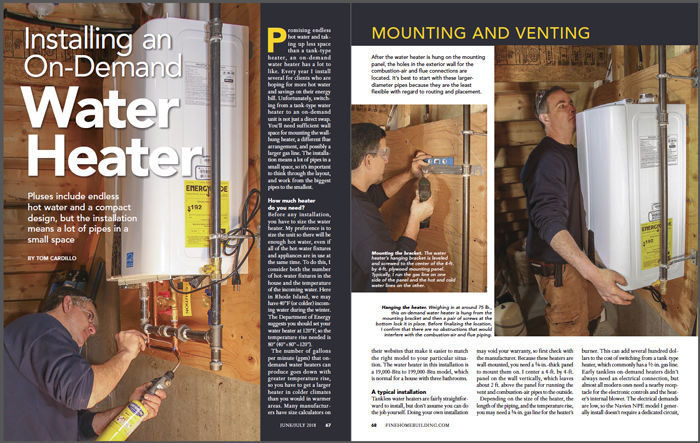Tankless Water Heater Installation Quirks and Tips
Consider codes and appliance requirements when installing tankless natural gas and propane water heaters.
Video Transcript: Tankless water heaters have some unique installation requirements that differ from standard water heaters. Here’s an overview.
When choosing a location, consider required clearances such as the space above, below, on each side, and in front of the unit. This information is available from every manufacturer.
The vent pipes can run either up through a roof or straight through a wall, and their lengths are limited by the manufacturer.
Other vent-clearance requirements include vent distance to windows, doors, eaves, other vent pipes, and the exterior grade level, which can vary by local code.
Tankless water heaters typically come with mounting hardware; in this case we’re using a supplied bracket that attaches directly to studs spaced 16 in. on center. If you can’t find solid backing, install a 3/4-in. plywood backer to ensure solid support.
Some models are designed to function with a 1/2-in. gas line in certain conditions, but many units require a 3/4-in. line to supply enough fuel to meet the heater’s demand, especially when it’s used in conjunction with other gas or propane appliances.
To provide enough water flow for multiple fixtures running at the same time, incoming cold and outgoing hot water lines need to be 3/4 in.
For power, gas-fed units only require a standard 120v electrical connection, and can be plugged into a standard, grounded outlet.
For more information, check out this article and PDF on How to Install a Tankless Water Heater.







View Comments
Tankless water heaters are problematic. I've had several and they are trouble. Scale buildup is a problem. They need special servicing to keep them running. They don't last as long as a typical water heater. How about discussing these issues?
Thunder & Jacek may live in different environments- Thunder in Minneapolis with well water- very hard, very cold incoming water and Jacek with Bull Run water in Portland, OR- much warmer incoming temperature & very pure water.
Everybody needs to clean their filters and folks with hard water need to de-scale regularly, sometimes as often as annually. De-scaling means pumping a mild acid (think vinegar) through the heat transfer passages. Not a big deal if you're a plumber or knowledgeable DIYer, at least $100 if you have to call a plumber. Unfortunately, as far as I know, there's no reliable way to determine that it's time for de-scaling. I believe some manufacturers claim to have non-scaling devices. Google "Matt Risinger, tankless" for a primer on descaling.
Hm...
I have mine since 2004, Noritz, supplying hot water on demand to three bathrooms and a kitchen 120' away from the heater. The only problem which I experienced so far was a faulty circuit board controlling the maximum temperature (122deg) and preventing the soaking tub from overflowing. The replacement is $100. The maintenance is about once a year, I clean the interior filters on the mixer valve, it takes about 15 minutes to do. Easy peasy. I have another 11 year old on demand heater which heats water ans well as the hydronic floor system. No troubles or maintenance there..
Good idea. keep it up!